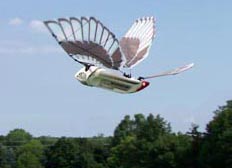|
The
Ornithopter Society
Founded
in 1984, The Ornithopter Society launched the modern
resurgence of flapping wing aircraft. Ornithopter Society
publications, including the Ornithopter Design Manual,
Flapping Wings newsletter, and online content, provide
the ultimate resource for those seeking to build ornithopters
or those interested in the history and culture of this unique
phenomenon.
Ornithopter (definition): An ornithopter is a manned
aircraft or an unmanned flying machine in which the driving
airfoils have a flapping, reciprocating, or oscillating
motion, instead of the rotary motion used in airplanes
and helicopters. |
|
 |
Download
the Ornithopter Design Manual
We are
making the Ornithopter Design Manual available for
free download. The Ornithopter Design Manual, written
by Patrick Deshaye and Nathan Chronister, offers the only
comprehensive treatment of ornithopter design and construction
techniques. You can also download the Flapper Facts and
Flapping Wings newsletters from 1984 through 2002.
Ornithopter
Design Manual (PDF)
Flapping
Wings Newsletter (1984-2002)
You can
visit the How To section
of this web site to get a quick introduction to building your
own ornithopters. Then read the Ornithopter Design Manual
and newsletters when you want to learn more. If you
find these resources helpful, please consider supporting
the work of the Ornithopter Society. Your small donation helps
cover the cost of maintaining and updating the website, while
most of the work to bring you the site is done on a voluntary
basis.
Why
Build Ornithopters?
People
will often ask what ornithopters are used for. Above any other
purpose, ornithopters are a great vehicle for learning. For
high school studionts, ornithopters are a great way to learn
about engineering, physics, math, electronics, and more! At
the university level, ornithopters are part of the advanced
research into aerodynamics, bird flight, and robotics. Individual
hobbyists also enjoy learning new skills as they rise to the
challenge of flapping wing flight!
|

Education.
Students can build ornithopters for a school
project. They can learn about engineering, physics,
math, electronics, and more!
|
|

Ornithopters
are a great
hobby for those who enjoy the challenge
of coming
up with their own designs. There are also ready-made
toy ornithopters if you just want to fly one.
|
Some other
applications for ornithopters have been implemented. Like
other types of radio controlled aircraft, ornithopters can
be used to carry cameras. Ornithopters can be made to look
like a real bird or insect, so they could be used for covert
spying. Ornithopters have also been used in studies of wildlife
where an aircraft resembling a real bird was needed. Another
application that has been tested is the use of ornithopters
to chase birds away from airports. Bird control specialists
use a variety of methods to keep birds away from runways.
If an airplane runs into birds, it can receive damage causing
it to crash, so this is an important part of airline safety.
Of course,
there has been some effort to develop ornithopters as a type
of manned aircraft. Adalbert Schmid, who in 1942 built the
first successful manned ornithopter, believed that flapping
wings would be more fuel-efficient than airplanes. Others
observed the high maneuverability of birds and thought that
manned ornithopters could emulate that ability. Regardless
of whether that is true, there are many people who just want
to have the experience of flying like a bird.
How Ornithopters Got Started
The idea
of the ornithopter came from ancient times. Three thousand
years ago, Assyrian stone carvings depicted God riding in
an ornithopter. The Greek legend of Daedalus and Icarus tells
of two men who built wings in order to escape from a labyrinth.
In 875 AD, Abbas ibn Firnas in Spain constructed a bird-inspired
aircraft, with which he made the first gliding flight by a
human.
In the
1870s, the focal point for the development of aviation was
in Paris. Unmanned aircraft were built, including ornithopters,
as a stepping stone to the development of manned flight. The
rubber-band-powered ornithopters developed then formed the
basis for modern designs that are built by students and hobbyists
today.
Steam
and internal combustion engines were then used, with some
great advancements taking place in Germany prior to World
War II. Alexander Lippisch, who is also known for developing
the Me 163 Komet rocket-powered fighter, led a team of young
researchers who perfected the design of engine-powered, unmanned
ornithopters, achieving successful flights up to 16 minutes.
Building on that work, in 1942 Adalbert Schmid made the first
successful flight of an engine-powered, manned ornithopter.
Although there have been a few others,
Schmid's manned ornithopter still stands as the most successful
to this day.
The first
radio-controlled ornithopter was built by Percival Spencer
in 1960. He also built a series of more bird-shaped, engine-powered
ornithopters. During the 1990s, Spencer's design was adapted
for electric power and came to greatly influence the design
of our modern RC ornithopters. Read more ornithopter
history.
|




